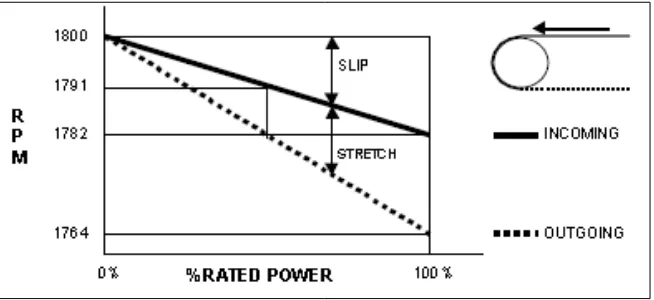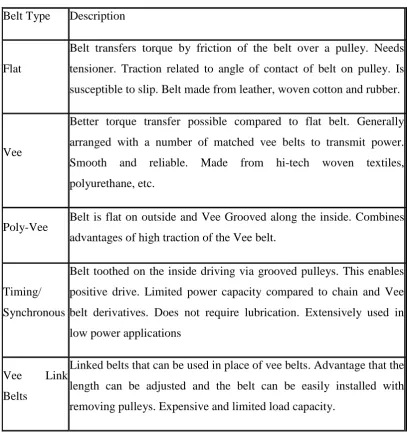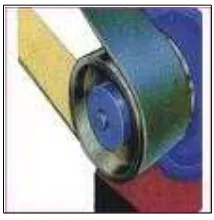STUDY OF BELT STRETCH IN RELATION TO ROTATIONAL SPEED
NUR AKHMAR BIN PARLAM
STUDY OF BELT STRETCH IN RELATION TO ROTATIONAL SPEED
NUR AKHMAR BIN PARLAM
This Report is Submitted to the Faculty of Mechanical Engineering in partial Fullfillment of the Partial Requirement for the award of
Bachelor of Mechanical Engineering (Structure & Materials)
Faculty of Mechanical Engineering Universiti Teknikal Malaysia Melaka
(UTeM)
ii
“I have read this literary work and in my opinion it is fully adequate, in scope and quality for the award of the degree of
Bachelor of Mechanical Engineering (Structure & Material)”
iii
“I declared that this project report entitled “Study of Belt Stretch” is written by me and is my own effort except the ideas and citations which I have clarified their
sources.”
Signature : ………
Name of Candidate : NUR AKHMAR BIN PARLAM
iv
ACKNOWLEDGEMENT
Firstly, I would like to say thank to my supervisor, Dr. Md Fahmi bin Abd. Samad @ Mahmood for his personal input, enthusiasm, encouragement and many constructive comments and remarks while doing this report.
I would like to say thank to all the lab technician that has been guided me on using the Test Gigs equipments and sharing some knowledge and comment in order to completing this report.
v
ABSTRACT
vi
ABSTRAK
ix
CONTENTS
CHAPTER DESCRIPTION PAGE
SUPERVISOR APPROVAL ii
DECLARATION iii
ACKNOWLEDGMENT iv
ABSTRACT v
ABSTRAK vi
CONTENT ix
LIST OF FIGURES x
LIST OF TABLES xi
LIST OF SYMBOLS xii
ix
CHAPTER DESCRIPTION PAGE
CHAPTER 1 INTRODUCTION 1
1.1 Background 1
1.2 Objectives of Study 2
1.3 Problem Statement 3
1.4 Scope of Project 4
1.5 Benefit of Study 4
CHAPTER 2 LITERATURE REVIEW 5
2.1 Introduction 5
2.2 Belt Drive 6
2.2.1 Flat Belts 8 2.2.2 Vee Belts (V-Belts) 9
2.3 Studies of Flat Belt 10
2.3.1 Flat Belt Design 11
2.3.2 Basic Theory 12
2.3.3 Belt Length Formula 14
2.3.4 Belt Tolerances 16
ix
CHAPTER DESCRIPTION PAGE
CHAPTER 2 LITERATURE REVIEW
2.5 The advantages and disadvantages
between v-belts and flat belts 19 2.6 The creep of belt due to belt stretch 21
CHAPTER 3 METHODOLOGY 22
3.1 Introduction 22
3.2 Parameter identifiable 22
3.3 Theory of belt drive 23
3.4 Data 26
3.5 Material selection/sample description 26 3.6 Measurement method and equipment 28
3.7 Experiment 29
3.7.1 Experiment on relation between speed
and stretch 29
3.7.2 Initializing the Equipment 29 3.7.3 Using the Instron Bluehill program 30
ix
CHAPTER DESCRIPTION PAGE
CHAPTER 3 METHODOLOGY
3.8.1 Project flow chart 32
3.8.2 Gantt chart 32
CHAPTER 4 RESULT AND DISCUSSION 33
4.1 Introduction 33
4.2 Effect of speed to belt stretch 33 4.2.1 Calculations of force at tension side, F1
for V-belt 34
4.2.2 Calculations of force at tension side, F1
for flat belt 43
4.2.3 Calculations of stretch for rubber V-belt
and percentage error 52
4.2.4 Calculations of stretch for rubber V-belt
and percentage error 55
4.3 The effect of speed to V-belt and
ix
CHAPTER DESCRIPTION PAGE
CHAPTER 5 CONCLUSION AND RECOMMENDATIONS 62
5.1 Conclusion 62
5.2 Recommendation 63
REFFERENCES 64
x
LIST OF FIGURES
NO. TITLE PAGE
1.1 Incoming and outgoing belt speed as a function of rated power. 3
2.1 Flat belts 8
2.2 Vee belts 9
2.3 Flat belt driver 10
2.4 Basic theory of belting 12
2.5 Illustration of pulley sizes 14
2.6 The graph efficiency of belt versus power 18
2.7 The open belt drive 21
3.1 Comparison of kinematics and kinetics of a pair of mating spur gears
and a belt around two pulleys 23
3.2 Belt’s plan view (specimen) 27
3.3 Cross sectional of V-belt and flat belt 28
xi
LIST OF TABLES
NO. TITLE PAGE
2.1 Types of belt drivers 7
2.2 Minimum recommended flat belt pulley diameters (mm) 11 2.3 Recommended flat belt drive pulley widths 12
2.4 Belt Tolerances 16
3.1 Example of total force acting on belt and stretch table 26 3.2 The dimensions and specifications of v-belt and flat belt 27
4.1 Effect of speed to V-belt stretch 59
xii
LIST OF SYMBOLS
CVT = continuously variable transmission
SFC = specific fuel consumption
WOT = wide open throttle
BSFC = brake specific fuel consumption
E-CVT = electronically continuously variable transmission
CAD = computer aided design
3D = three dimensions
DC = direct current
AC = alternate current
R = Resistor value
xiii
LIST OF APPENDICES
NO. DESCRIPTION PAGE
A Flow chart for PSM 1 & PSM 2 66
B Gantt chart for PSM 1 67
C Gantt chart for PSM 2 68
D The data for flat belt 1 69
E The data for flat belt 2 70
F The data for V-belt 1 71
CHAPTER 1
INTRODUCTION
1.1 Background
2
The polyester fibers are less likely to stretch, and therefore the resulting belt has less likelihood of stretching than the belt without the fibers. Although the fibers in the belt improve the stretch- resistance of the belt, the tendency of the belt to stretch has still remained a problem. Since the belt is typically formed from a length of material, the fibers are no continuous loops. In other words, along the length of the belt, the fibers are continuous.
However, at the point where the ends of the belt are connected to one another, the fibers may be next to one another, but they are not continuous. Therefore, the weak point in a belt seems to be the point at which the ends are connected. For this reason, the focus of many attempts to reduce the problem of belt stretch have focused on manipulating the fibers at the point of connection, resulting in the development of complicated techniques for connecting the ends of the belts. Although many of these techniques have improved the problem of belt stretching, there still exists a need for providing a belt having a reduced tendency to stretch. In particular there is a need for a belt that resists stretch and is economical to produce.
1.2 Objective of study
The objective of this project is to study belt stretch. Before starting this project, several targets and goals have been set to achieve a good the relationship between the belt stretch and the speed of motor. The following are the goals for this project:
a) To setup an experiment of studying belt stretch.
b) To conduct an experiment to study the effect of belt stretch in relation to various rotational speed.
3
1.3 Problem Statement
[image:19.595.157.484.363.513.2]Belt stretch introduces an extra dimension to the load-sharing problem. In order for a drive drum to transfer power to a belt, it must increase tension in the belt by stretching the belt so that a section of belt entering the drum is longer than the same section of belt as it leaves the drum. In order to stretch a belt, speed of the drum must be equal to or greater than belt speed at all points of contact. Ideally, the speed of a belt entering a drum is equal to the speed of the contact surface of the drum, and the speed of the belt leaving the drum is lower by the amount of belt stretch. Figure 1 applies to a drive drum with 1782-rpm motors (1% slip) and a belt that stretches by 1% at rated power—a stretch-to-slip ratio of 1.0 for the drum. For illustration, speed is referenced to the motor shaft.
Figure 1.1: An example of incoming and outgoing belt speed as a function of rated power.
4
1.4 Scopes of project
Based on the objective of this project, several scopes have been decided to achieve all these objectives:
a) To use only commercially available belt.
b) To conduct a study to at least 3 different rotational speed.
c) To conduct the experiment in the limitations of available laboratory equipment and environment.
1.5 Benefit of study
CHAPTER 2
LITERATURE REVIEW
2.1 Introduction
A belt is a looped strip of flexible material, used to mechanically link two or more rotating shafts. They may be used as a source of motion, to efficiently transmit power, or to track relative movement. Belts are looped over pulleys. In a two pulley system, the belt can either drive the pulleys in the same direction, or the belt may be crossed, so that the direction of the shafts is opposite. As a source of motion, a conveyor belt is one application where the belt is adapted to continually carry a load between two points.
6
Belt drive, moreover, is simple, inexpensive, and does not require axially aligned shafts. It helps protect the machinery from overload and jam, and damps and isolates noise and vibration. Load fluctuations are shock-absorbed (cushioned). They need no lubrication and minimal maintenance. They have high efficiency (90-98%, usually 95%), high tolerance for misalignment, and are inexpensive if the shafts are far apart. Clutch action is activated by releasing belt tension. Different speeds can be obtained by step or tapered pulleys.
However, the angular-velocity ratio may not be constant or equal to that of the pulley diameters, due to slip and stretch. However this problem has been largely solved by the use of toothed belts. Temperatures range from −35°C (−31 °F) to 85 °C (185 °F). Adjustment of center distance or addition of an idler pulley is crucial to compensate for wear and stretch.
2.2 Belt drive
A belt drive is a method of transferring rotary motion between two shafts. A belt drive includes one pulley on each shaft and one or more continuous belts over the two pulleys. The motion of the driving pulley is, generally, transferred to the driven pulley via the friction between the belt and the pulley. Synchronous/timing belts have teeth and therefore do not depend on friction. Gear transmissions have a much greater life expectancy than belt drives. Belt drives also have relatively high inspection and maintenance demands. On the other hand, belt drive has the following advantages:
7
e) Maintenance is relatively convenient
f) Very quiet compared to chain drives, and direct spur gear drives.
[image:23.595.114.522.310.747.2]For belt drives, other than synchronous drives, the belts will slip in a high overload event providing a certain measure of safety. The belts transferring torque by surface friction need to be in tension. This results in the need for adjustable shaft centres or using tensioning pulleys.
Table 2.1: Types of belt drivers Belt Type Description
Flat
Belt transfers torque by friction of the belt over a pulley. Needs tensioner. Traction related to angle of contact of belt on pulley. Is susceptible to slip. Belt made from leather, woven cotton and rubber.
Vee
Better torque transfer possible compared to flat belt. Generally arranged with a number of matched vee belts to transmit power. Smooth and reliable. Made from hi-tech woven textiles, polyurethane, etc.
Poly-Vee Belt is flat on outside and Vee Grooved along the inside. Combines advantages of high traction of the Vee belt.
Timing/ Synchronous
Belt toothed on the inside driving via grooved pulleys. This enables positive drive. Limited power capacity compared to chain and Vee belt derivatives. Does not require lubrication. Extensively used in low power applications
Vee Link Belts
8
[image:24.595.265.372.114.224.2]2.2.1 Flat belts
Figure 2.1: Flat belts
Flat belts as shown in Figure 2.1 were used early in line shafting to transmit power in factories. It is a simple system of power transmission that was well suited to its day. It delivered high power for high speeds (372.85 kW for 50.8 m/s), in cases of wide belts and large pulleys. These drives are bulky, requiring high tension leading to high loads, so vee belts have mainly replaced the flat-belts except when high speed is needed over power. The Industrial Revolution soon demanded more from the system, and flat belt pulleys need to be carefully aligned to prevent the belt from slipping off. Because flat belts tend to slip towards the higher side of the pulley, pulleys were made with a slightly convex or "crowned" surface (rather than flat) to keep the belts centered. The flat belt also tends to slip on the pulley face when heavy loads are applied. Many proprietary dressings were available that could be applied to the belts to increase friction, and so power transmission. Grip was better if the belt was assembled with the hair (i.e. outer) side of the leather against the pulley although belts were also often given a half-twist before joining the ends, so that wear was evenly distributed on both sides of the belt. Belts were joined by lacing the ends together with leather thronging or later by patent steel comb fasteners. A good modern use for a flat belt is with smaller pulleys and large central distances. They can connect inside and outside pulleys, and can come in both endless and jointed construction.


